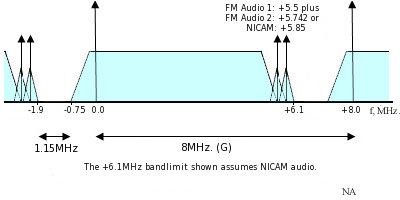 | ||
CCIR System G is an analog broadcast television system used in many countries. There are several systems in use and letter G is assigned for the European UHF system which is also used in the majority of Asian and African countries. (However some countries in Europe use different systems.)
Contents
Specifications
Some of the important specs are listed below.
A frame is the total picture. The frame rate is the number of pictures displayed in one second. But each frame is actually scanned twice interleaving odd and even lines. Each scan is known as a field (odd and even fields.) So field rate is twice the frame rate. In each frame there are 625 lines (or 312.5 lines in a field.) So line rate (line frequency) is 625 times the frame frequency or 625•25=15625 Hz.
The RF parameters of the transmitted signal are exactly the same as those for System B which is used on the 7.0 MHz wide channels of the VHF bands. The only difference is the width of the guard band between the channels, which on System G is 1.0 MHz wider than for System B: in other words 1.15 MHz (assuming the worst case which is when NICAM sound is in use).
System H
A few countries (Belgium, Luxembourg and Netherlands) use a variant of system G which is known as System H. System H is similar to system G but the lower (vestigial) side band is 500 kHz wider. This makes much better use of the 8.0 MHz channels of the UHF bands by reducing the width of the guard-band by 500 kHz to the still perfectly generous value of 650 kHz.
